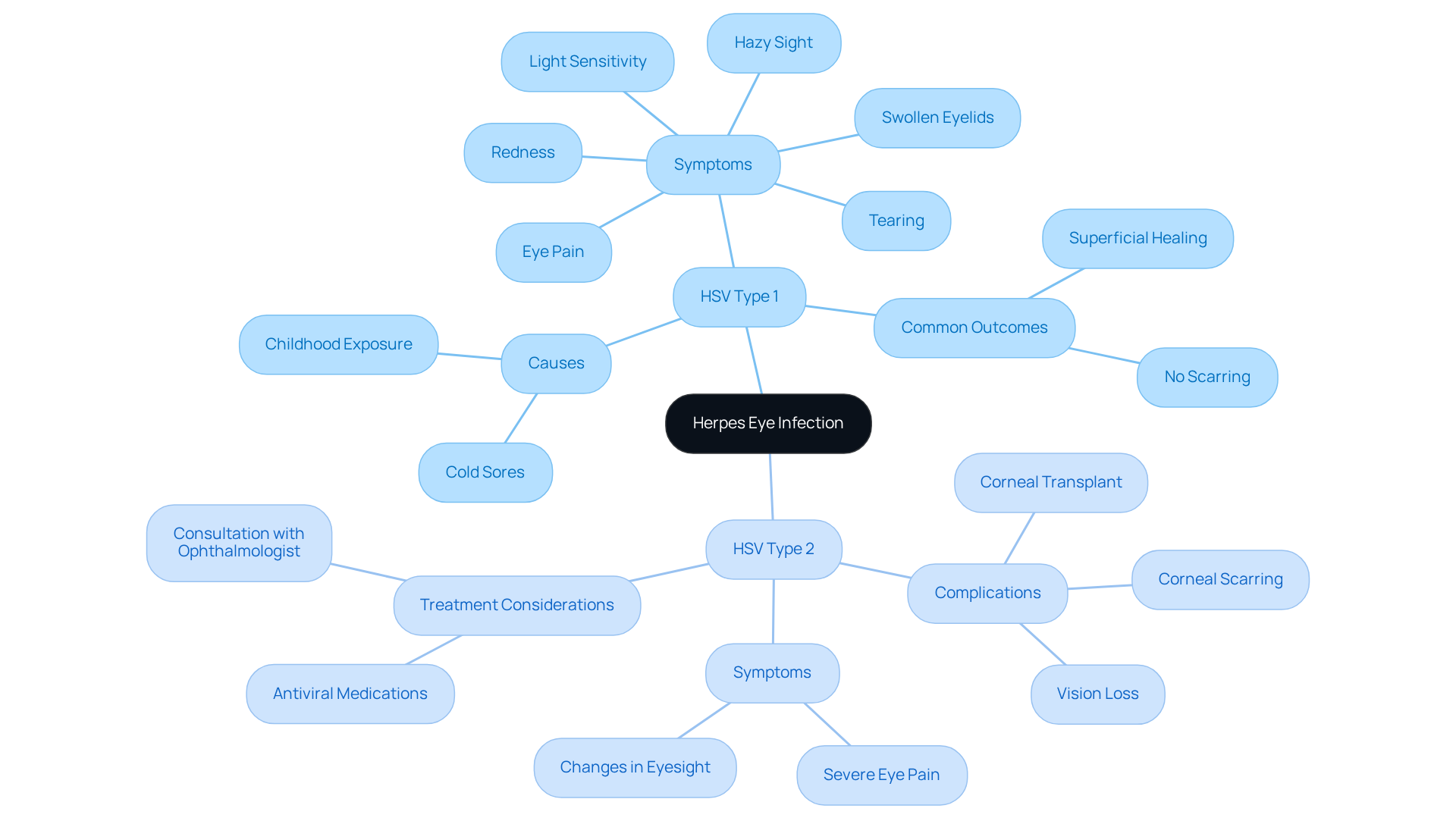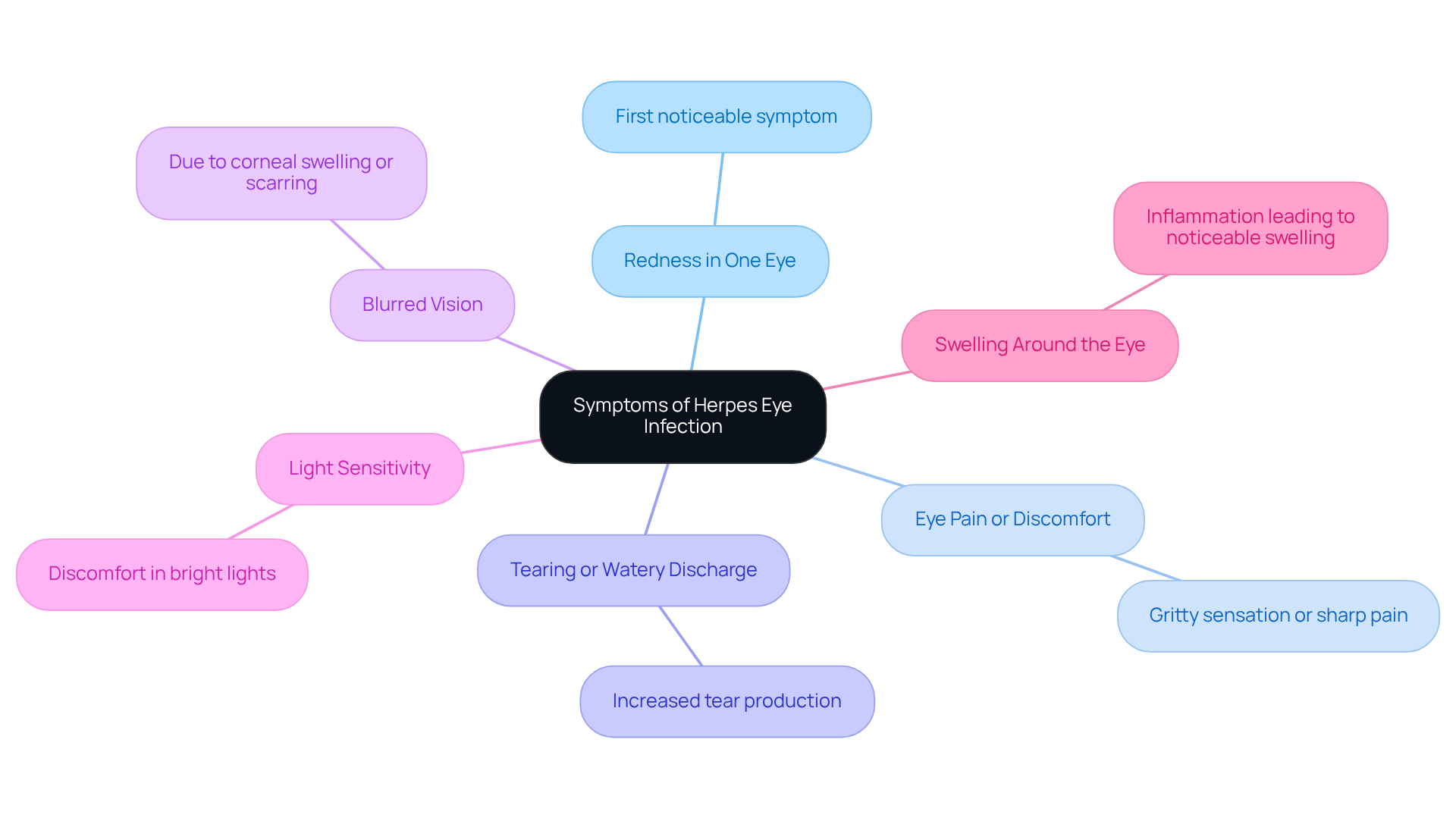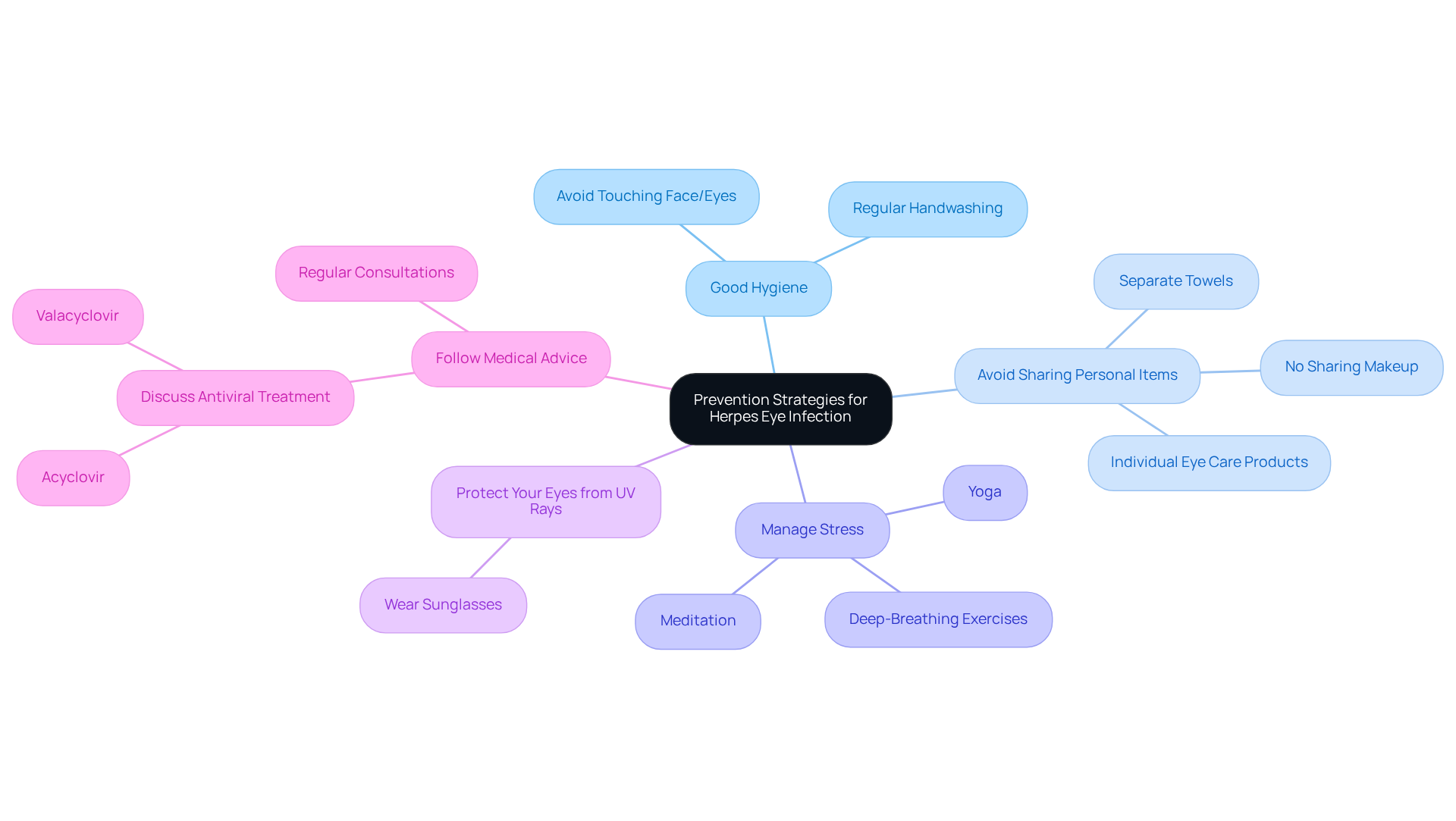Posted by: Northwest Eye in General on October 28, 2025
Overview
Herpes eye infection, primarily caused by the herpes simplex virus (HSV), can be a concerning issue. It manifests in two main types:
- HSV Type 1, which is linked to keratitis
- HSV Type 2, which can lead to severe complications in newborns
We understand that experiencing symptoms such as eye pain and redness can be distressing. It’s crucial to recognize these signs early and seek prompt treatment with antiviral medications. Good hygiene practices can also play a vital role in reducing the risk of recurrence and serious complications.
Remember, you are not alone in this journey. We are here to help you through this process, providing support and guidance every step of the way.
Introduction
Ocular health is often overlooked, and we understand that this can be concerning. It is important to recognize that viral infections, particularly those caused by the herpes simplex virus (HSV), can significantly impact your eye health. Understanding herpes eye infections is crucial, as they can lead to serious complications, including vision impairment.
This article delves into the symptoms, treatment options, and prevention strategies for herpes eye infections. We aim to provide you with essential knowledge to safeguard your eye health. How can you effectively identify and manage these infections to prevent long-term damage? We are here to help you through this process.
Define Herpes Eye Infection: Overview and Types
Ocular viral conditions, often referred to as herpes eye infections, can be concerning and are mainly triggered by the herpes simplex virus (HSV). We understand that learning about this can be overwhelming, so let’s break it down together. There are two main types of HSV that can affect the eyes:
-
HSV Type 1: This strain is most often linked to cold sores and is the primary cause of keratitis, which mainly impacts the cornea. Approximately 90% of the population has been exposed to HSV Type 1, often during childhood, making it a prevalent concern for eye health. Superficial viral outbreaks that impact only the cornea’s outer layer typically resolve without scarring, providing some reassurance.
-
HSV Type 2: While primarily recognized for causing genital herpes, this strain can also lead to eye infections, particularly in newborns during childbirth. Though not as frequent, HSV Type 2 can lead to severe complications if it affects the eye, including the possible requirement for a corneal transplant due to scarring and loss of sight.
Comprehending these categories is essential for precise diagnosis and efficient treatment. We want to stress that neglecting these conditions can result in various complications, including possible loss of sight. If you’re experiencing worsening eye pain, changes in eyesight, or persistent swollen eyelids, immediate medical consultation is advised.
Herpes eye infections can present in various forms, such as epithelial keratitis, stromal keratitis, and iridocyclitis. Each type requires specific management strategies to mitigate risks and preserve vision. For instance, stromal keratitis, which affects deeper layers of the cornea, can lead to scarring and may necessitate surgical intervention if not promptly treated.
Individuals with eye infections often need to take antiviral medications indefinitely, as the virus remains in the body and can reactivate. Current studies continue to investigate the implications of these illnesses, focusing on prevention and treatment options to decrease recurrence rates and enhance patient outcomes.
Typical signs of eye infection consist of:
- Eye discomfort
- Redness
- Tearing
- Light sensitivity
- Hazy sight
- Swollen eyelids
- Blisters or rashes around the eye
We understand the importance of prompt intervention, as untreated ailments can result in serious complications, including lasting loss of sight. Remember, we are here to help you through this process.

Identify Symptoms of Herpes Eye Infection
Symptoms of herpes eye infection can vary, and we understand how concerning this can be. Typical signs to watch for include:
- Redness in one eye: Often, this is the first noticeable symptom.
- Eye pain or discomfort: You might feel a gritty sensation or sharp pain.
- Tearing or watery discharge: Increased tear production can occur as your eye attempts to flush out the virus.
- Blurred vision: This can happen due to corneal swelling or scarring.
- Light sensitivity: Bright lights may feel uncomfortable.
- Swelling around the eye: Inflammation can lead to noticeable swelling.
If you experience any of these symptoms, especially if you have a history of cold sores, it’s important to consult an eye care professional for evaluation and potential treatment of a herpes eye infection. Remember, you are not alone in this—seeking help is a strong and positive step towards feeling better.

Explore Treatment Options for Herpes Eye Infection
Treatment for herpes eye infection often involves antiviral medications, which can be administered in various forms.
We understand that facing a herpes eye infection can be concerning, and we are here to support you through this process. Here are some common treatment options:
- Topical Antivirals: Eye drops or ointments containing antiviral agents like acyclovir or ganciclovir are commonly prescribed to directly address the ailment.
- Oral Antivirals: For more severe cases or recurring illnesses, medications like valacyclovir or famciclovir may be suggested.
- Supportive Care: In addition to antiviral therapy, cold compresses can help alleviate discomfort, and over-the-counter pain relievers may also provide relief.
- Follow-Up Care: Regular follow-up appointments are crucial to monitor the illness’s progress and adjust treatment as necessary.
It’s common to feel anxious about the potential complications of untreated eye conditions, including herpes eye infection, caused by the virus. Timely care is essential, as neglecting these symptoms can lead to severe complications, including corneal scarring and vision impairment. Remember, you are not alone in this; we are here to support you every step of the way.

Implement Prevention Strategies for Herpes Eye Infection
To effectively reduce the risk of herpes eye infection, we understand that you may be looking for practical prevention strategies. Here are some compassionate suggestions to help you:
- Maintain Good Hygiene: Regular handwashing is crucial, particularly before touching your face or eyes. It’s important to avoid contact with your eyes if you have cold sores, as this can facilitate the spread of the virus. As Dr. Grace Zhang highlights, “Individuals should take measures to prevent the recurrence of the virus, including washing hands frequently and avoiding contact with the eye, especially if they have a cold sore.”
- Avoid Sharing Personal Items: We know that sharing towels, makeup, or eye care products can increase the risk of transmission. Keeping personal items separate is essential for preventing the spread of the virus.
- Manage Stress: It’s common to feel that stress triggers outbreaks of simplex keratitis. Engaging in stress-reduction techniques such as meditation, yoga, or deep-breathing exercises can help mitigate this risk.
- Protect Your Eyes from UV Rays: Wearing sunglasses not only protects your eyes from harmful UV exposure but can also help prevent flare-ups associated with sun damage.
- Follow Medical Advice: For individuals with a history of herpesvirus outbreaks, discussing preventive antiviral treatment, such as Acyclovir or Valacyclovir, with a healthcare provider can be advantageous. Regular consultations can help tailor a prevention plan that suits your individual needs.
By adopting these strategies, you can significantly lower your risk of developing a herpes eye infection and enhance your overall eye health. With over 1.8 million people affected by herpetic eye disease annually, proactive measures are essential for maintaining eye wellness. Remember, we are here to help you through this process.

Conclusion
Understanding herpes eye infections is crucial for safeguarding your eye health and ensuring timely treatment. We recognize that learning about this condition can be overwhelming, but it’s important to know that you are not alone in this journey. This article has explored the different types of herpes simplex virus (HSV) that can affect the eyes, specifically HSV Type 1 and Type 2. By recognizing symptoms early, you can prevent serious complications and protect your vision.
Key insights covered include various symptoms associated with herpes eye infections, such as:
- Eye discomfort
- Redness
- Watery discharge
- Light sensitivity
We understand how distressing these symptoms can be, but there are effective treatment options available. Antiviral medications and supportive care are essential for managing this condition, and we encourage you to seek medical attention if you experience any of these signs. Furthermore, practical prevention strategies are vital; good hygiene, stress management, and protective measures against UV rays can make a significant difference.
In conclusion, proactive engagement in understanding herpes eye infections is vital for maintaining your eye health. By adopting preventive measures and seeking timely treatment, you can minimize your risk of infection and contribute to a broader awareness of this often-overlooked condition. We are here to help you through this process. Taking these steps can lead to healthier eyes and a better quality of life, underscoring the significance of eye care in your overall well-being.
Frequently Asked Questions
What is a herpes eye infection?
A herpes eye infection, also known as an ocular viral condition, is primarily triggered by the herpes simplex virus (HSV) and can lead to various complications affecting the eyes.
What are the two main types of herpes simplex virus that can affect the eyes?
The two main types are HSV Type 1, which is commonly linked to cold sores and primarily causes keratitis affecting the cornea, and HSV Type 2, which is mainly recognized for genital herpes but can also lead to eye infections, particularly in newborns.
What is keratitis, and how is it related to HSV Type 1?
Keratitis is an infection of the cornea, and HSV Type 1 is the primary cause of this condition. It typically impacts the outer layer of the cornea and often resolves without scarring.
What complications can arise from HSV Type 2 eye infections?
HSV Type 2 can lead to severe complications, including significant scarring and potential loss of sight, which may require a corneal transplant.
What are the different forms of herpes eye infections?
The different forms include epithelial keratitis, stromal keratitis, and iridocyclitis, each requiring specific management strategies.
What are the typical signs of a herpes eye infection?
Typical signs include eye discomfort, redness, tearing, light sensitivity, hazy sight, swollen eyelids, and blisters or rashes around the eye.
Why is prompt medical consultation important for herpes eye infections?
Prompt medical consultation is crucial because untreated infections can lead to serious complications, including lasting loss of sight.
What treatment options are available for herpes eye infections?
Individuals often need to take antiviral medications indefinitely, as the virus remains in the body and can reactivate. Specific management strategies depend on the type of infection.
What should I do if I experience worsening eye pain or changes in eyesight?
If you experience worsening eye pain, changes in eyesight, or persistent swollen eyelids, you should seek immediate medical consultation.






